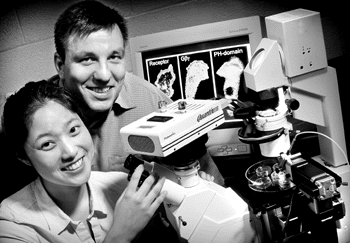|
|
Meet the Digital AmoebaStudent creates computer model that aids biologists in study of human cells
By Phil Sneiderman |

As an undergraduate biomedical engineering major, Jane H. Kim developed a two-dimensional computer model that simulates the inner workings of a tiny amoeba that behaves like a human white blood cell. Her electronic model is aiding biologists who believe these microscopic animals hold the key to creating new treatments for diseases ranging from asthma and psoriasis to cancer.
Kim presented her model at the International Symposium on Computational Cell Biology, held recently in Lenox, Mass. The 22-year-old student, who just graduated, is remaining at Hopkins over the summer to continue refining the project.

|
| As an undergraduate, Jane H. Kim, seen here with postdoc Chris Janetopoulos, developed a simulation of a microbe that scientists believe is key to creating new treatments for diseases. |
Kim has focused her research on the chain of events that trigger and guide movement in a widely studied organism called Dictyostelium discoideum.
A Dictyostelium is a single-celled organism that lives in the soil and feeds on bacteria, leading a solitary life until its food supply is exhausted. When these animals begin to starve, they signal each other and join together to form a new multicellular organism. This process of picking up chemical signals and moving toward the source is called chemotaxis. It closely resembles the way in which human white blood cells track down and destroy bacteria and other pathogens that release a chemical "scent" or trail. Biologists who study Dictyostelium believe that understanding chemotaxis will help them develop new drug therapies for a range of diseases.
Kim's collaborators say her chemotaxis simulation represents very advanced research. "I think it is highly unusual for an undergraduate to develop such a complex model," said Chris Janetopoulos, a postdoctoral fellow in the Department of Cell Biology and Anatomy at the School of Medicine. "Not only does Jane seem to grasp the biological phenomena, she also has a firm understanding of computer modeling and programming." Janetopoulos has been working with Kim to determine how well her model predicts the behavior of live Dictyostelium in a lab.
Kim, whose studies included a concentration in electrical and computer engineering, developed her model by pursuing a research opportunity offered last year by Pablo Iglesias, a professor in the Department of Electrical and Computer Engineering. Iglesias and Andre Levchenko, a postdoctoral fellow at Cal Tech, had already created a pioneering one-dimensional model of Dictyostelium. Iglesias sought a student to expand upon this research by devising a more detailed two-dimensional version, using new software called Virtual Cell.
"I just jumped at the opportunity," Kim said. She learned how to use the challenging software during an internship last summer at the University of Connecticut Health Center, then returned to Johns Hopkins to work on the project.
Building on the mathematical foundation created by Iglesias and Levchenko, Kim created a two-dimensional model that replicates the chemotaxis process in Dictyostelium. The model, being tested in a lab set up by Peter Devreotes, a professor in the School of Medicine's Department of Biological Chemistry, is designed to save time and money by steering biologists toward the experiments that are most likely to yield useful results.
"Although it's still in the developmental phase, Jane's computer model is already beginning to mimic the biological response we see in the cell during chemotaxis," Janetopoulos said. "It is unlikely that it can mirror what we see in the living cell precisely, but one of our goals is to watch the virtual cell respond to a chemical gradient. Then, on the computer, we change the way the components are interacting or add new ones and see what happens. This type of experimentation can help us direct our efforts toward finding certain proteins and analyzing certain pathways more aggressively."
In developing the model, Kim said training her engineering skills on a biology problem was particularly helpful. "A cell can be seen as a microscopic machine," she said. "A biologist may not look at it that way, but an engineer does. We can break it down into equations. A biologist may see the cell as a living organism, but we engineers look at the mathematics behind the science. It makes for a really great collaboration."
Kim, whose mother is a nurse, has long been interested in helping others through medical research and treatment. As a child visiting relatives in Korea, she was involved in a serious car accident that claimed the lives of her grandparents and left Kim hospitalized with injuries. The experience taught her about the importance of prompt and up-to-date medical care, which is often lacking in poor, rural areas. The message was brought home again last summer when she volunteered at a Connecticut health clinic for migrant workers who could not afford regular visits to a physician. "It was an eye-opening experience," she said.
Kim's project was supported by a Johns Hopkins Biomedical Engineering Dean's Research Award and by a National Science Foundation Biocomplexity Award given to Iglesias and Devreotes. Next fall, Kim plans to continue her computational biology research when she enters the M.D./Ph.D. program at the University of Southern California's Keck School of Medicine.
| GO TO JUNE 25, 2001 TABLE OF CONTENTS. |
| GO TO THE GAZETTE HOME PAGE. |